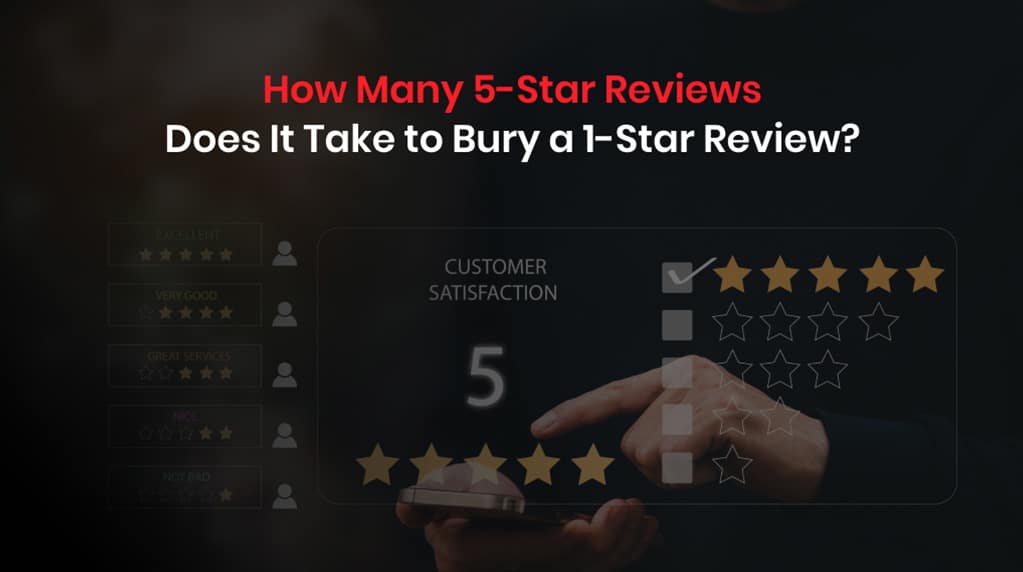You know the feeling. It’s a Friday afternoon, service was a little chaotic but mostly smooth, and you’re feeling proud of your team. You check your phone, pull up Google, and your stomach plummets to the floor.
It’s there. A single, gleaming, angry 1-star review.
The reason? “Fries were good but they forgot to put ketchup in the bag.”
All your hard work, the team’s effort, the perfectly cooked burgers… overshadowed by a condiment that costs five cents. Your hard-earned, respectable 4.8-star rating just took a nosedive, and now this digital graffiti is sitting there for all to see. This isn’t just frustrating; it feels fundamentally unfair. But what if you had a plan? What if you knew exactly what it takes to recover and had a playbook to make sure this one bad moment doesn’t define your business?
Let’s dive in.
The Brutal, Unforgiving Math of a Bad Review
Before we talk strategy, let’s get one thing straight: your online rating is just simple, brutal math. There’s no algorithm for “context” or “they were probably just having a bad day.” It’s a calculation, and that one review just threw a wrench in it.
Let’s imagine your restaurant, “The Golden Fry,” has a solid 4.8-star rating. This is a fantastic, believable score built on 50 reviews. To achieve this, your review profile might look something like this:
- 45 glowing 5-star reviews
- 5 solid, but not perfect, 3-star reviews
The math checks out: [(45 x 5) + (5 x 3)] / 50 = 240 / 50 = 4.8 stars. You’re a trusted local favorite.
Now, let’s factor in that ketchup-less tragedy.
-
Enter: The 1-Star Wrecking Ball:
-
You now have 240 stars + 1 star = 241 total stars.
-
You now have 50 reviews + 1 review = 51 total reviews.
-
Your new average rating is: 241 ÷ 51 = 4.725 stars.
-
Just like that, you’ve dropped from a stellar 4.8 to a 4.7. While it may not seem like a huge leap, it can be the difference between a customer choosing you or the 4.8 competitor down the street. It pulls you further away from the top tier.
Watch the podcast on YouTube where Arun AV along with Rev Ciancio talk about ‘Reputation Management’.
To listen:
The Long, Painful Climb Back
So, how many new, perfect 5-star reviews do you need just to claw your way back to your original 4.8-star rating? This is where it gets even more painful than our last example.
The sobering answer?
In this realistic scenario, it takes approximately 19 new 5-star reviews to recover the ground lost by a single 1-star review.
The math is relentless. That one moment of human error requires nearly twenty moments of absolute perfection just to get back to where you started. Feeling a little desire to take control of this situation? Good. Here’s how:
Your Reputation Management Playbook: Defense, Offense, and Intelligence
You can’t just sit back and hope for more 5-star reviews to magically appear. You need a system.
Part 1: The Defense – Taming the 1-Star Beast
When you get a bad review, your first instinct is either to get angry or to ignore it. Both are wrong. That review is now a permanent part of your restaurant’s “digital front door.” Ignoring it is the online equivalent of a customer complaining in person and you just staring at them blankly. You wouldn’t do that, right?
Your response isn’t just for the unhappy customer; it’s for the hundreds of potential customers who will read it later.
Use the 3-A Framework for your reply:
- Acknowledge: Address their specific complaint directly. Don’t be defensive. “We’re so sorry to hear we missed the ketchup in your bag.”
- Apologize: Offer a sincere apology for the mistake and the frustration it caused. “That’s frustrating and not the standard we aim for. We apologize for the oversight.”
- Act: State what you’re doing about it and invite them back. “We’re retraining our team on double-checking to-go orders. We’d love the chance to make it right. Please email me at owner@yourrestaurant.com so I can personally send you a voucher for your next meal.”
This response shows you care, you’re professional, and you’re committed to quality. You’ve just turned a negative into a net positive for everyone else reading.
Part 2: The Offense – Activating Your Silent, Happy Majority
For every one person who complains, there are dozens who had a fantastic meal and said nothing. They are your silent majority, and you need to give them a gentle, non-annoying nudge to speak up.
Leaving reviews needs to be easier than complaining.
- Make it Obvious: Put a QR code on your receipts or table tents that links directly to your Google review page. The fewer clicks, the better.
- Ask at the Right Time: When a customer compliments the food in person, train your staff to say, “That’s so great to hear! It would mean the world to us if you shared that experience in a Google review. It really helps our business.”
- Leverage Your Email List: Have a simple, automated “thank you” email go out after a delivery order with a clear, one-click link to leave a review.
This proactive approach of generating positive reviews is a cornerstone of great marketing. It doesn’t just help your star rating; it sends powerful signals to search engines and is a core part of effective
Part 3: The Unfair Advantage – Listening at Scale
What if you could spot the “missing ketchup” problem before it leads to a dozen 1-star reviews?
The problem with just reading reviews is that you’re always playing catch-up. The real power comes from analyzing the data within them. A platform that uses AI can scan hundreds of reviews from Google, Yelp, and internal surveys to find trends you’d miss. It can automatically categorize feedback and tell you that “cold fries” have been mentioned 7 times this week at your downtown location, or that “service speed” is a recurring issue during the lunch rush.
This is intelligence. It allows you to fix small operational issues before they become full-blown reputation crises.
We dove deep into this very topic with our CEO, Arun, on our podcast. If you want to hear how the former data architect for Starbucks’ engagement platform thinks about turning feedback into action, you need to listen.
Listen to Episode 20: Building a Bulletproof Reputation here
It’s Time to Take Control
A single 1-star review feels like a crisis, but it’s really an opportunity. It’s a chance to show your community how much you care, to refine your operations, and to build a system that protects your hard-earned (and believable) reputation.
The system is simple:
- Play Defense: Respond to every review, especially the bad ones.
- Play Offense: Make it incredibly easy for happy customers to share their feedback.
- Play with Intelligence: Use modern tools to analyze feedback at scale and fix problems before they start.
This entire playbook—from managing reviews, to sending automated emails asking for more, to analyzing the data within them—is exactly what platforms like Qubriux are built for.
Stop letting a missing packet of ketchup dictate your success. It’s time to build a reputation that’s not just great, but genuine.
Related Read: How to develop customer loyalty: A guide.
Watch the podcast on Reputation Management
Watch the podcast on YouTube where Arun AV along with Rev Ciancio talk about ‘Reputation Management’.
To listen:
About Qubriux:
We help restaurants leverage the power of data and analytics to understand their customers on a deeper level. Imagine knowing exactly what makes your audience tick, their preferred dishes, and even their social media habits. With this knowledge, you can personalize your offerings, tailor your promotions, and tailor a loyalty program that resonate with your customers.
The result? A loyal following who not only loves your food but actively promotes your restaurant on their own social media channels.
Ready to take your restaurant’s marketing to the next level? Fill out the form below and let’s chat about how Qubriux can help you create a winning strategy that drives sales and builds lasting customer relationships.


